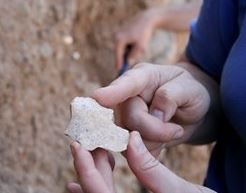Our ancestors passed through the gateway to Europe from Asia about 1.2 million years ago, which was much earlier than previously thought, says a team of scientists who discovered the oldest recorded stone tool ever to be found in Turkey.
The team, from Royal Holloway, University of London, as well as an international team from the UK, the Netherlands and Turkey, said their chance find of a humanly-worked quartzite flake in western Turkey, in ancient deposits of the Gediz river, gave scientists a much better understanding of how early humans ventured out of Africa and Asia.
The research has been published in the journal Quaternary Science Reviews.
The scientists used high-precision measuring equipment to date the deposits of the ancient river meander, giving the first accurate timeframe for when the area was occupied by humans.
The oldest recorded stone tool ever to be found in Turkey. (Photo: Royal Holloway)
Professor Danielle Schreve, who works at the Department of Geography at Royal Holloway, said:
“This discovery is critical for establishing the timing and route of early human dispersal into Europe. Our research suggests that the flake is the earliest securely-dated artefact from Turkey ever recorded and was dropped on the floodplain by an early hominin well over a million years ago.”
The research team used palaeomagnetic measurements from lava flows and high-precision radioisotopic dating, which both post-date and pre-date the meander, to establish that humans occupied the area between about 1.24 million and 1.17 million years ago.
A previous (2007) study recovered the oldest hominin fossils in western Turkey. However, it was difficult to determine a timeframe for them.
Professor Schreve said:
“The flake was an incredibly exciting find. I had been studying the sediments in the meander bend and my eye was drawn to a pinkish stone on the surface. When I turned it over for a better look, the features of a humanly-struck artefact were immediately apparent.”
“By working together with geologists and dating specialists, we have been able to put a secure chronology to this find and shed new light on the behavior of our most distant ancestors.”
Citation:
“The earliest securely-dated hominin artefact in Anatolia?” D. Maddy, D. Schreve, T. Demir, A. Veldkamp, J.R. Wijbrans, W. van Gorp, D.J.J. van Hinsbergen, M.J. Dekkers, R. Scaife, J.M. Schoorl, C. Stemerdink, T. van der Schriek. Quaternary Science Reviews. Volume 109, 1 February 2015, Pages 68–75. doi:10.1016/j.quascirev.2014.11.021.

